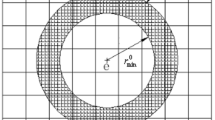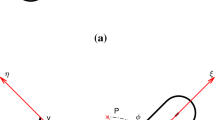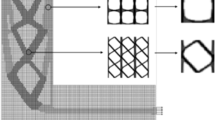Abstract
Length scale control in topology optimization is an important area of research with direct implications on numerical stability and solution manufacturability. Projection-based algorithms for continuum topology optimization have received considerable attention in recent years due to their ability to control minimum length scale in a flexible and computationally efficient manner. In this paper, we propose a new projection-based algorithm that embeds minimum length scale control on two material phases (e.g., solid and void) as well as optional maximum length scale on one material phase (e.g., solid or void) into the projection methodology used for material distribution approaches to topology optimization. The proposed algorithms are demonstrated on benchmark problems and are shown to satisfy the length scale constraints imposed.














Similar content being viewed by others
References
Allaire G, Jouve F, Michailidis G (2016) Thickness control in structural optimization via a level set method. Struct Multidiscip Optim 53(6):1349–1382
Bendsøe MP (1989) Optimal shape design as a material distribution problem. Struct Optim 1(4):193–202
Bendsøe MP, Sigmund O (1999) Material interpolation schemes in topology optimization. Arch Appl Mech 69(9–10):635–654
Borrvall T (2001) Topology optimization of elastic continua using restriction. Arch Comput Meth Eng 8 (4):351–385
Bourdin B (2001) Filters in topology optimization. Int J Numer Methods Eng 50(9):2143–2158
Bruns TE, Tortorelli DA (2001) Topology optimization of non-linear elastic structures and compliant mechanisms. Comput Methods Appl Mech Eng 190(26):3443–3459
Carstensen JV, Guest JK (2014) New projection methods for two-phase minimum and maximum length scale control in topology optimization. In: 15th AIAA/ISSMO Multidisciplinary Analysis and Optimization Conference, Atlanta, pp 1–11
Clausen A, Aage N, Sigmund O (2016) Exploiting additive manufacturing infill in topology optimization for improved buckling load. Engineering 2(2):250–257
Diaz A, Sigmund O (1995) Checkerboard patterns in layout optimization. Struct Multidiscip Optim 10 (1):40–45
Gaynor AT, Guest JK (2014) Topology optimization for additive manufacturing: considering maximum overhang constraint. In: Proceedings of the 15th AIAA/ISSMO multidisciplinary analysis and optimization conference, Atlanta, pp 1–8
Gaynor AT, Guest JK (2016) Topology optimization considering overhang constraints: eliminating sacrificial support material in additive manufacturing through design. Struct Multidiscip Optim 54(5):1157–1172
Gaynor AT, Meisel NA, Williams CB, Guest JK (2014) Multiple-material topology optimization of compliant mechanisms created via polyjet three-dimensional printing. J Manuf Sci Eng 136(6):061015–1–061015–10
Guest JK (2009a) Imposing maximum length scale in topology optimization. Struct Multidiscip Optim 37 (5):463–473
Guest JK (2009b) Topology optimization with multiple phase projection. Comput Methods Appl Mech Eng 199(1):123–135
Guest JK (2015) Optimizing the layout of discrete objects in structures and materials: a projection-based topology optimization approach. Comput Methods Appl Mech Eng 283:330–351
Guest JK, Smith Genut LC (2010) Reducing dimensionality in topology optimization using adaptive design variable fields. Int J Numer Methods Eng 81(8):1019–1045
Guest JK, Zhu M (2012) Casting and milling restrictions in topology optimization via projection-based algorithms. In: ASME 2012 International Design Engineering Technical Conferences and Computers and Information in Engineering Conference, Chicago, pp 913–920
Guest JK, Prévost JH, Belytschko T (2004) Achieving minimum length scale in topology optimization using nodal design variables and projection functions. Int J Numer Methods Eng 61(2):238– 254
Guest JK, Asadpoure A, Ha S-H (2011) Eliminating beta-continuation from heaviside projection and density filter algorithms. Struct Multidiscip Optim 44(4):443–453
Guo X, Zhang W, Zong W (2014) An explicit length scale control approach in simp-based topology optimization. Comput Methods Appl Mech Eng 282:71–86
Ha S-H, Guest JK (2014) Optimizing inclusion shapes and patterns in periodic materials using discrete object projection. Struct Multidiscip Optim 50(1):65–80
Langelaar M (2017) An additive manufacturing filter for topology optimization of print-ready designs. Struct Multidiscip Optim 55(3):871–883
Lazarov BS, Wang F (2017) Maximum length scale in density based topology optimization. Comput Methods Appl Mech Eng 318:826–844
Petersson J, Sigmund O (1998) Slope constrained topology optimization. Int J Numer Methods Eng 41 (8):1427–1434
Poulsen TA (2003) A new scheme for imposing a minimum length scale in topology optimization. Int J Numer Methods Eng 57(6):741–760
Qian X (2017) Undercut and overhang angle control in topology optimization: a density gradient based integral approach. Int J Numer Methods Eng 111(3):247–272
Sigmund O (2007) Morphology-based black and white filters for topology optimization. Struct Multidiscip Optim 33(4–5):401–424
Sigmund O (2009) Manufacturing tolerant topology optimization. Acta Mech Sinica 25(5):227–239
Sigmund O, Petersson J (1998) Numerical instabilities in topology optimization: a survey on procedures dealing with checkerboards, mesh-dependencies and local minima. Struct Multidiscip Optim 16(1):68–75
Sigmund O, Torquato S (1997) Design of materials with extreme thermal expansion using a three-phase topology optimization method. J Mech Phys Solids 45(6):1037–1067
Stolpe M, Svanberg K (2001) An alternative interpolation scheme for minimum compliance topology optimization. Struct Multidiscip Optim 22(2):116–124
Svanberg K (1987) The method of moving asymptotes: a new method for structural optimization. Int J Numer Methods Eng 24(2):359–373
Tootkaboni M, Asadpoure A, Guest J K (2012) Topology optimization of continuum structures under uncertainty—a polynomial chaos approach. Comput Methods Appl Mech Eng 201:263–275
Wang F, Lazarov B S, Sigmund O (2011) On projection methods, convergence and robust formulations in topology optimization. Struct Multidiscip Optim 43(6):767–784
Watts S, Tortorelli DA (2017) Optimality of thermal expansion bounds in three dimensions. Extreme Mech Lett 12:97–100
Wu J, Aage N, Westermann R, Sigmund O (2018) Infill optimization for additive manufacturing—pproaching bone-like porous structures. IEEE Trans Vis Comput Graph 24(2):1127–1140
Xu S, Cai Y, Cheng G (2010) Volume preserving nonlinear density filter based on heaviside functions. Struct Multidiscip Optim 41(4):495–505
Yan S, Wang F, Sigmund O (2018) On the non-optimality of tree structures for heat conduction. Int J Heat Mass Transf 122:660–680
Zhou M, Lazarov BS, Wang F, Sigmund O (2015) Minimum length scale in topology optimization by geometric constraints. Comput Methods Appl Mech Eng 293:266–282
Acknowledgements
The work was supported by the US National Science Foundation under Award Number 1400394. Any opinions, findings, and conclusions or recommendations expressed in this article are those of the author(s) and do not necessarily reflect the views of the National Science Foundation.
Author information
Authors and Affiliations
Corresponding author
Additional information
Responsible Editor: Ole Sigmund
Publisher’s Note
Springer Nature remains neutral with regard to jurisdictional claims in published maps and institutional affiliations.
Rights and permissions
About this article
Cite this article
Carstensen, J.V., Guest, J.K. Projection-based two-phase minimum and maximum length scale control in topology optimization. Struct Multidisc Optim 58, 1845–1860 (2018). https://doi.org/10.1007/s00158-018-2066-4
Received:
Revised:
Accepted:
Published:
Issue Date:
DOI: https://doi.org/10.1007/s00158-018-2066-4




